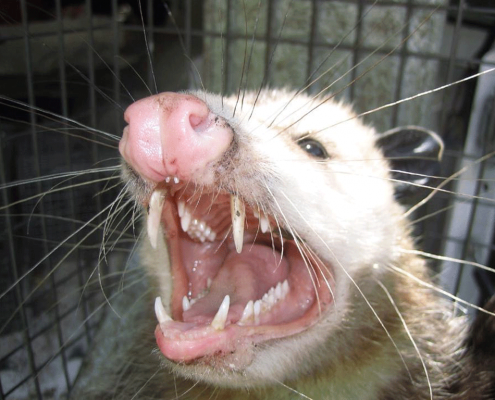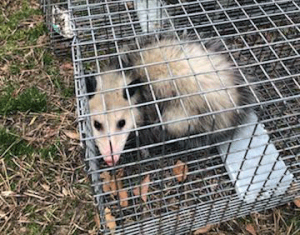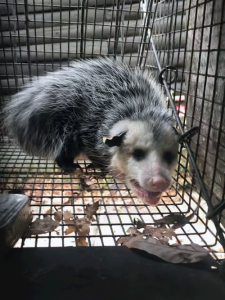
Everything you need to know about the opossum
The opossum is one of the oldest mammals in the world; Scientists have found fossils of this species dating back 65 million years, the time when dinosaurs became extinct. The opossum is one of the most popular marsupials in the world. In the American continent alone, there are almost 100 different species of this mammal. Its rat-like appearance generates dislike in some people. However, this cute animal does not cause any risk, unlike rodents. One of its main characteristics is docility towards humans.
Some people choose it as a pet.
Despite this, the care that an opossum needs surpasses the good intentions of those who buy or catch it. In many cases, he is released into a habitat that does not belong to him, which causes him to die. Another reason for death is the slowness of the opossum; they are hit by cars very often. Thus hundreds of possum females die carrying puppies in their pouches. These baby opossums remain orphans and have little chance of surviving.
Opossum Solutions
Opossum Description
The opossum is found in North America, South America, Australia, and Oceania. He spends most of his day sleeping in the trees, rock crevices, abandoned burrows, etc., and goes out at night to find food.
The possum can live 2 to 3 years in the wild and up to 6 years in captivity.
Their small, bright eyes are perfectly positioned in the head, and their muzzle is elongated. The tone of the hair can vary between gray, brown, black, and white. An opossum’s tail is devoid of fur and helps him to attach himself to tree branches. The possum is a small mammal from the marsupial family. It measures between 65 and 85 centimeters long in total, including the tail which, alone, can be 40 cm. With a weight between 1 and 5 kg, it is hardly larger than a cat.
Its fur is more or less dark gray all over its body, except for the face and the throat, which are white in color, and its pink nose. Certain species of possum have a prehensile tail, that is to say, it allows them to curl and cling to objects. They use it in particular to climb trees.
Opossums reproduce 1 to 3 times a year, depending on their living environment. The female generally gives birth to a litter of 6 to 9 young, after a gestation period of 12 to 14 days after mating. When they are born, the young are around 1 cm tall and weigh less than a gram. They have no visible eyes or ears. As soon as they are born, they cling to their mother's udder, where they will be breastfed for about 70 days, after which they are weaned and become independent.
They don’t waste the food that they find. They eat fruits, leaves, reptiles, flowers, birds, insects, and even small mammals. Furthermore, having moved from its natural habitat to the borders of cities and towns, the opossum also feeds on leftovers from food and the remains of other animals. He has very sharp teeth and a jaw with extraordinary strength that allows him to swallow his prey voraciously. This animal is omnivorous; it feeds on fruits and seeds, but especially on insects and other small animals such as frogs, snakes, birds, earthworms, insects, and small mammals.
The possum has the particularity of knowing how to play dead and to give off a repulsive odor when a predator seizes it.
It has oddly shaped wide feet and five toes. The hind foot has a large thumb-like toe that they use to grab branches. The front print settles in the “V” “forefinger” of the hind print and the thumb. They have five toes on each foot and walk on all four. Their print will be around two inches in diameter. The print of the back foot is slightly larger. You may see the drag marks in their tracks because their long tail often drags behind them.
The droppings they leave behind can be used to identify them. Their droppings look like the poop of a dog and around 3/4" in diameter. But opossum droppings are not broken in small pieces and are generally one large dropping. Their feces are 1–2" in length that may be covered in yellowish or white mold growth and have smooth sides. Their fresh droppings are brown in color. Their fecal matter has a unique characteristic- when the opossum excretes the waste, it tends to curl.
During day to day activity, they are almost silent, so it isn't easy to detect them. However, you can hear different kinds of sounds the opossum makes, including rumbling, growling, hissing, and screeching. When they forage for food rustling in tall grass or shrubs, homeowners might hear the rustling sound. Moreover, the mother and offspring develop inimitable communication that can be compared to the noises of birds. Their offspring have a unique cry, and their mothers respond to them with clicking sounds.
They are not noisy animals, but they generate hissing, clicking and growling sounds as well. In the breeding season, you may hear their hissing and growling sounds when opossums are looking for their mates. The young opossums will produce sneeze-like sounds when they call out for their mothers. When it feels threatened, the opossum emits cries and whistles intended to impress and scare away the opponent. According to studies, their threatening sounds have a varied intensity and highly complex pitch. The ring-tail opossums, like gliders, are less vocal and produce the soft call. They tend to be vocal when young opossums get separated from their parents or aggressive. When they’re highly active, they produce a high-pitched chirruping twitter.
What does an opossum den look like?  The opossum is a marsupial that can be seen in North America. They change their den’s location very frequently even after a few days to avoid predators. That’s why they can adapt to a variety of different environments i.e., forest, underground, urban areas, and more. They don’t put much effort into setting up their dens- instead, they hunker down in whatever place keeps them warm, safe, and dry for a few days.
The opossum is a marsupial that can be seen in North America. They change their den’s location very frequently even after a few days to avoid predators. That’s why they can adapt to a variety of different environments i.e., forest, underground, urban areas, and more. They don’t put much effort into setting up their dens- instead, they hunker down in whatever place keeps them warm, safe, and dry for a few days.
Habitat of the opossum
They prefer the woody habitats; most opossums live in the deciduous forests that shed their leaves. They can also be found close by rivers, lakes, streams, or other water sources. They are highly adaptable and can survive in urban areas.
Underground dens:
They are not very keen diggers like rabbits, groundhogs, or badgers, but they live in underground dens and burrows. They don’t dig their own nest; instead, they prefer to move into the old den that has been uninhabited by other animals. Once they have claimed the den, they fill it with grass and dried leaves. These soft nesting materials make the den a dry place to live.
Tree nests in forests
Opossums are pretty at home in the forest. This wild animal has powerful claws and prehensile tails that makes it a strong climber and helps it grasp branches. Opossums are common in the forest, but they live in trees in the suburbs that are close to running sources of water or streams. They don’t prefer to live in deeper parts of the forest. They set up their nests in trees or forest dens in the fallen hollow logs, piles of bushes, and rock crevices. They use tree openings to build nests or use woodpiles and burrows from other animals. Further, they are experts in climbing and spend a lot of time in the trees and dig the tree bark with the help of their sharp claws.
Urban-dwelling den
Their adaptive nature lets them live in close proximity with people in urban areas. They have the ability to scavenge for rotten fruit, garbage, pet food, and roadkill. They also hunt snails, mice, beetles, and other harmful insets- providing a type of pest control.
Their urban-dwelling den is found in garages, porches, firewood piles, inside sheds, and underneath houses.
Dens in winter
Although it is a furry animal, its fur doesn’t provide much insulation in the cold weather. It spends the winter in its dens that are safe, dry, and protected. The opossum is vulnerable to snow, so it “holes up” during extremely cold spells. Its dens may be in wood piles, hollow trees, spaces in buildings, dug burrows, and rock crevices. They make their nests with leaves and dry grass to protect themselves from extreme weather conditions. Their curled-up tails help them to carry the soft materials for nesting. In winter, they may venture indoors. They may build their nest in your chimney, crawl space, and attic when looking for a den site in your house.
Are Opossums Dangerous? The opossum is a marsupial that is native to North America and often carries a lot of misconceptions. You may wonder whether or not this nocturnal animal poses any danger to your pets and family. What if this growling scavenger carries diseases? Will they bite or scratch? You may want to know whether or not this creepy wildlife creature may attack you. If all these questions ring a bell in your mind, read on to know more about this marsupial and whether they pose a threat.
The opossum is a marsupial that is native to North America and often carries a lot of misconceptions. You may wonder whether or not this nocturnal animal poses any danger to your pets and family. What if this growling scavenger carries diseases? Will they bite or scratch? You may want to know whether or not this creepy wildlife creature may attack you. If all these questions ring a bell in your mind, read on to know more about this marsupial and whether they pose a threat.
The American Opossum
Most people assume that the American opossum is a type of large rat due to its furry appearance. But they’re not rodents even though they look similar in many ways. It is the only North American native marsupial. They carry their offspring in a pouch, like a kangaroo.
Are Opossums Dangerous?
This is a frequently asked question, “Are opossums dangerous?” The answer is that they are not aggressive, but if they feel threatened, they can be dangerous. It can be scary for most people when they find this animal in their yard. This wild creature has a unique appearance, and most of us enjoy watching marsupials, at a safe distance. Homeowners don’t consider them very disturbing or scary due to their looks, but they might be a possible threat due to their nature of damaging the structural integrity of homes. Unlike other wild animals, they do not have the potential to carry diseases like rabies. But opossums may use parts of your house to build a place to nest.
Are Opossums Dangerous To Humans?
This wild animal is referred to as the “possum” in the Midwest and the southern United States of America. They are likely to roam over large places and don’t stay in one place for a long period. They usually eat smaller rodents, harmful insects, and grubs, meaning having an opossum around can help keep the populations of other pests down. They remain silent and don’t respond when humans approach them. They aren’t afraid of humans and don’t react from the shine of a flashlight. The lack of fear of people from any wild creature like an opossum means they can be dangerous. If you are looking for the answer (Yes or no) to the question, “are opossums dangerous?” The answer is most definitely, “Yes!”
Do Opossums Attack Pets?
They are passive in nature and shy away from conflict. When confronted by other wild animals or predators, they usually play dead. They often don’t attack pets, so your pets are likely to be safe from this wild animal. According to the Opossum Society of the United States, it is more likely that a dog will kill or injure an opossum instead of the other way around. When talking about cats, they may possibly kill baby opossums (rat-sized). But cats and adult opossums have been seen to show mutual respect for one
another.
